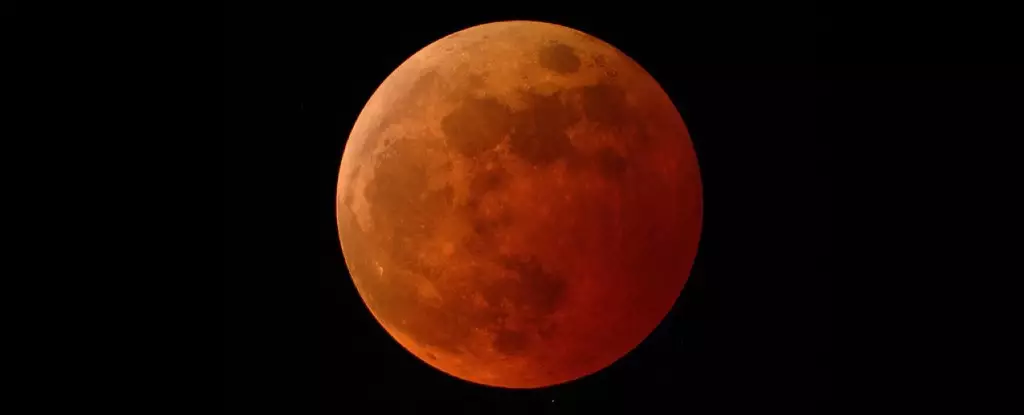On an exciting night soon approaching, our celestial neighbor, the Moon, is set to undergo a transformation that promises to mesmerize stargazers worldwide. Scheduled for late Thursday, this rare cosmic event—a total lunar eclipse—will see the Moon shimmering in hues of red. This captivating phenomenon, often dubbed a “Blood Moon,” occurs when the Earth, the Sun, and the Moon align precisely, casting our planet’s shadow over the Moon. However, rather than extinguishing the Moon’s glow, Earth’s shadow paints it in shades of crimson. As if nature itself is performing a celestial ballet, this spectacle invites both awe and contemplation.
The Science Behind the Spectacle
Astronomers, including Daniel Brown from Nottingham Trent University, provide insights into this fascinating occurrence. According to them, the reddish hue that envelops the Moon results from sunlight bending and scattering through Earth’s atmosphere—akin to the breathtaking colors we witness during sunrise and sunset. Unlike the stark white of the Moon in a clear sky, the Blood Moon glows with a captivating warmth, bringing an enchanting aesthetic to the night.
Intriguingly, the atmosphere’s condition plays a significant role in this captivating transformation. The presence of dust or clouds may intensify the redness, making the lunar orb appear even more vivid. Thus, the celestial phenomenon offers not just a visual treat, but an opportunity for scientific understanding of our planetary environment, where the behavior of light interacts with the cosmic stage.
Historical Significance and Cultural Perspectives
The term “Blood Moon” carries a weighty connotation, often tied to foreboding omens and prophecies. However, Brown shares an alternative view, highlighting that such interpretations stem from a misguided understanding of eclipses. While many in contemporary societies might view the Blood Moon with trepidation, various cultures have historically embraced these events with optimism and reverence.
Take, for instance, the Native American tribes who associated March’s full Moon with renewal and rebirth, labeling it the “Blood Worm Moon.” This distinction reveals an appreciation for lunar cycles that resonates with themes of growth and change rather than doom. In certain African cultures, lunar eclipses symbolize conflicts, specifically the age-old struggle between celestial bodies. These perspectives challenge a singular negative narrative, offering a richer tapestry of human experience and beliefs surrounding this enchanting lunar event.
Timings and Viewing Experiences
For most of North America, spectators will kick off their eclipse experience at 1:09 AM Eastern Time when the Moon begins to show signs of “eating.” Totality, the period when the Earth’s shadow fully encompasses the Moon, will occur between 2:26 AM and 3:31 AM. European viewers in the far west, particularly in regions like Brittany, will have fleeting access to this cosmic performance before the Moon sets beneath the horizon.
Yet, not all will experience this vivid display to its complete extent. For instance, New Zealanders will have a different perspective, as the Moon will only partially eclipse upon its rise. Observers around the globe are encouraged to seek clear skies and optimal viewing conditions, embracing the unpredictability of Mother Nature to seize a glance at this momentous lunar event.
Beyond the Blood Moon: Upcoming Celestial Events
This particular Blood Worm Moon possesses an added layer of intrigue due to its status as a “Micromoon.” At its greatest distance from Earth, the Moon will appear diminutive, about seven percent smaller than usual, contrasting sharply with last year’s Supermoon. For enthusiasts craving even more celestial wonders, later this month promises an exhilarating partial solar eclipse on March 29, visible in various regions across Canada, Europe, and parts of Africa. It’s crucial for viewers to approach this event with caution, as observing a solar eclipse without appropriate eye protection can be hazardous.
In essence, as we prepare our gazes heavenward, we embrace not only the distinct beauty of the Blood Worm Moon but also the scientific and cultural narratives woven into its fabric. The night sky serves as a reminder of the interconnectedness of humanity, nature, and the universe—a magnificent display capable of igniting our imaginations and inspiring collaboration on this shared journey through existence.

